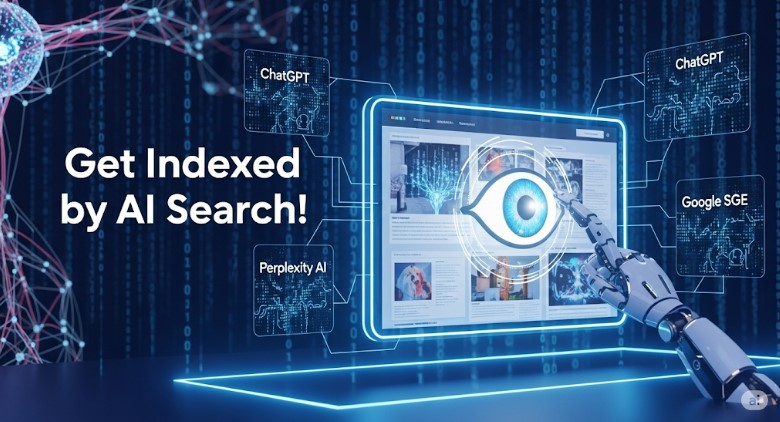As AI-powered search and retrieval systems grow—like ChatGPT browsing, Perplexity AI, Google Search Generative Experience (SGE), and other AI-based answer engines—getting your website or content discovered and cited by AI crawlers is becoming more important than ever. These systems often generate summaries, cite sources, or even answer users’ questions using live content from across the web.
If you’re a blogger, publisher, eCommerce brand, SaaS company, or content marketer, here’s how to ensure your site is AI-crawlable, indexable, and preferably cited by modern AI platforms.
What Is AI Search Crawling?
Traditional search engines like Google use web crawlers (bots) to index your site for keyword-based search. But AI systems such as ChatGPT with browsing, Perplexity AI, and Microsoft Copilot pull contextual or semantic information from the web. They often cite sources in real time.
So, “getting crawled” by AI means ensuring these bots can access your content, understand it semantically, and optionally cite it in response to user queries.
Why AI Crawlers Matter in 2025 and Beyond
-
Traffic Diversification: AI answers may cite your content or link users to your page.
-
Authority Building: Being quoted by AI tools builds brand and content credibility.
-
First-Mover SEO Edge: Few websites are actively optimizing for AI search today.
-
Voice Search & Assistant Optimization: AI search often powers voice assistants.
Step-by-Step: How to Get Crawled by AI Search Engines
1. Create High-Quality, Original Content
AI models prioritize content that is:
-
Factual
-
Well-structured
-
Helpful
-
Human-readable
Write content that answers questions clearly, especially in FAQ or “What is…” formats. AI tools love content with semantic depth.
Tip: Use simple headers (H1, H2) and answer-focused paragraphs.
2. Make Your Site Crawlable
Check your robots.txt file. It should allow crawling by both search engine bots and AI crawlers.
-
Your content is not behind a paywall
-
Noindex tags aren’t accidentally added
-
Pages are mobile-friendly and load fast
3. Submit Your Sitemap to Major Engines
A sitemap helps crawlers find your content. Submit it to:
-
Google Search Console
-
Bing Webmaster Tools
-
Yandex (optional)
-
OpenAI & Perplexity (via indirect discovery)
Note: OpenAI and Perplexity currently don’t accept direct sitemap submissions but use Bing and public linking to discover content.
4. Get Indexed by Bing and Google
Since many AI systems (like ChatGPT with browsing or Perplexity AI) pull real-time data via Bing or Google APIs, ensure you’re properly indexed there.
To do this:
-
Submit your sitemap to Bing Webmaster Tools
-
Index fresh content using URL Inspection in Google Search Console
5. Use Structured Data (Schema Markup)
Use schema.org structured data to help AI tools better understand your content. Add markups like:
-
Article
-
FAQPage
-
HowTo
-
Product
-
Organization
Example for a FAQ:
6. Build Authority and Trustworthiness
E-E-A-T (Experience, Expertise, Authoritativeness, Trustworthiness) is not just for Google anymore—AI models are trained to favor trustworthy content.
-
Use author bios
-
Add external citations
-
Link internally to related posts
-
Keep your site updated
7. Earn Backlinks from High-Authority Sources
AI tools often crawl domains with strong backlink profiles. Backlinks signal importance.
Strategies to build backlinks:
-
Guest posting
-
Digital PR
-
Linkable assets (statistics, original research)
-
Directory listings
8. Use Public and Shareable URLs
Make sure the content you want cited is:
-
Public (not behind login)
-
Shareable (no restrictions)
-
Unique (avoid duplicate content)
If you have valuable PDFs, tools, or guides—make them publicly accessible and optimized.
9. Add Q&A or FAQ Sections
AI systems love question-answer style content. This helps with:
-
Featured snippets
-
Voice search
-
AI summarization
Format them cleanly using H3s or schema markup.
Example:
Q: How do I get my website cited in ChatGPT?
A: Ensure your content is public, optimized for clarity, and indexed by Bing or Google.
10. Avoid Blocking AI Crawlers
Some publishers use robots.txt to block bots like ChatGPT’s GPTBot or Perplexity’s crawler (CCBot). Unless you have a policy reason, do not block them.
You can specifically allow OpenAI’s GPTBot:
Bonus Tip: Monitor Your Site Mentions in AI Tools
Search for your site name in:
-
Bing AI Chat
-
ChatGPT (with browsing)
-
Google SGE (if available)
This helps you understand if and how your content is being cited.
Optimizing for AI search crawl is now an essential part of future-proof SEO. By creating helpful content, ensuring indexability, and building trust signals, you can increase your chances of being discovered and cited by AI systems like ChatGPT, Perplexity, and Bing AI.
As these systems shape the next era of search, early adopters will have a huge advantage.
Parivesh Singh Gupta is the founder of TweeLabs, with over 12+ years of experience in digital marketing, SEO content writing, web development, and eCommerce solutions. He specializes in WordPress development, Meta & Google Ads, Shopify & WooCommerce, Canva-based design, and AI automation.
Parivesh helps startups and growing businesses achieve online success through high-converting strategies, powerful ad campaigns, and SEO-rich content that ranks.
For collaborations or consulting:
Email: parivesh@tweelabs.com
Website: www.tweelabs.com
Follow on LinkedIn: Parivesh Singh Gupta

